Hellenic Railways Organisation
 | |
| private company | |
| Industry | Rail transport |
| Founded | 1 January 1971 |
| Headquarters | Athens, Greece |
Key people |
OSE Group President & Managing Director: I. Petropoulos |
| Products | Rail transport |
| Revenue |
|
|
| |
|
| |
| Owner | Greek Government |
| Subsidiaries | Erga OSE (Ergose)[3] |
| Website | Official website |
The Hellenic Railways Organization or OSE (Greek: Οργανισμός Σιδηροδρόμων Ελλάδος or Ο.Σ.Ε.) is the Greek national railway company which owns, maintains and operates all railway infrastructure in Greece with the exception of Athens' rapid transit lines. Train services on these lines are run by TrainOSE S.A., a former OSE subsidiary. In addition OSE owns and maintains the rolling stock used by TrainOSE and maintains preserved special rolling stock, withdrawn locomotives and railcars. OSE was founded in 1971,[4] taking over from the Hellenic State Railways, which was founded in 1920.

main, secondary, under construction.
![]()
Primary rail network
As in most European Union countries, administration of the railway infrastructure is separate from the railway operating companies using the network to provide passenger and freight transportation services. Up until November 2010, company EDISY S.A. was the actual manager of the Greek national railway infrastructure until it became a subsidiary of OSE.[5] Specifically on 29 November 2010 EDISY S.A. was merged back into the parent company OSE S.A., which is today the manager of the rail infrastructure of Greece.[6][7]
The major lines of the Greek railway network consist of the mostly electrified standard gauge double track line from Piraeus-Athens to northern Greece-Thessaloniki, a single track electrified line from Thessaloniki to Idomeni (at the border with the Republic of Macedonia) and the mixed-gauge line from Athens to Peloponnese. Almost all other lines link directly with these two lines. The main line of the Greek Railway System from Athens to Thessaloniki, covers a distance of 520 kilometres (320 mi).
According to the 2007 Network Statement, the total length of the standard gauge lines was approximately 1,665 kilometres (1,035 mi), while the length of the metre gauge lines (excluding Krioneri–Missolonghi–Agrinio line) is about 725 km (450 mi). In addition, about 150 km (93 mi) of new standard gauge lines towards Athens Airport and to replace metre gauge lines, became fully operational in July 2007.
Piraeus – Athens
| Piraeus railways (2009) | |||||||||||||||||||||||||||||||||||||||||||||||||||||||||||||||||||||||||||||||||||||||||||||||||||||||||||||||||||||||||||||||||||||||||||||||||||||||||||||||||||||||||||
|---|---|---|---|---|---|---|---|---|---|---|---|---|---|---|---|---|---|---|---|---|---|---|---|---|---|---|---|---|---|---|---|---|---|---|---|---|---|---|---|---|---|---|---|---|---|---|---|---|---|---|---|---|---|---|---|---|---|---|---|---|---|---|---|---|---|---|---|---|---|---|---|---|---|---|---|---|---|---|---|---|---|---|---|---|---|---|---|---|---|---|---|---|---|---|---|---|---|---|---|---|---|---|---|---|---|---|---|---|---|---|---|---|---|---|---|---|---|---|---|---|---|---|---|---|---|---|---|---|---|---|---|---|---|---|---|---|---|---|---|---|---|---|---|---|---|---|---|---|---|---|---|---|---|---|---|---|---|---|---|---|---|---|---|---|---|---|---|---|---|---|---|
| |||||||||||||||||||||||||||||||||||||||||||||||||||||||||||||||||||||||||||||||||||||||||||||||||||||||||||||||||||||||||||||||||||||||||||||||||||||||||||||||||||||||||||
Legend | |||||||||||||||||||||||||||||||||||||||||||||||||||||||||||||||||||||||||||||||||||||||||||||||||||||||||||||||||||||||||||||||||||||||||||||||||||||||||||||||||||||||||||
| |||||||||||||||||||||||||||||||||||||||||||||||||||||||||||||||||||||||||||||||||||||||||||||||||||||||||||||||||||||||||||||||||||||||||||||||||||||||||||||||||||||||||||
Piraeus is served by two terminals. One at Piraeus Harbour (Πειραιεύς Λιμήν, 37°56′55″N 23°38′08″E / 37.94861°N 23.63556°E), which up until 2006 was used by some standard gauge trains for Chalkis, Thessaloniki, and Alexandroupolis. The short line to Agios Ioannis Rentis is closed and as of 2009 being renovated. The heavy rolling stock repair works (Piraeus Central Factory, Κεντρικό Εργοστάσιο Πειραιώς — ΚΕΠ) are located at Lefka (37°57′17″N 23°39′03″E / 37.95472°N 23.65083°E), next to Ergostasio halt, and are accessible from this line.
The other Piraeus mainline station (Peloponnese Station, 37°56′57″N 23°38′36″E / 37.94917°N 23.64333°E) was used by the Peloponesse metric line trains until 2005, when it was converted to standard gauge, reopening in 2007 and today serving the Proastiakos rail service. The two lines from Piraeus meet just outside Agios Ioannis Rentis (AIR) marshalling yard (37°57′41″N 23°39′55″E / 37.96139°N 23.66528°E). Next to the marshalling yard lies the major rolling stock depot and maintenance facility of OSE (MAI).
North of AIR, the line crosses Kifissos River and then passes through the freight and parcels handling station of Rouf. At a siding of Rouf station, there is a "railway theater" in disused rolling stock and a disused SEK class Μα "2-10-2" steam locomotive made by Breda (37°58′27″N 23°42′14″E / 37.97417°N 23.70389°E). The line between Rouf and Athens Central (Larissis Station) is single track and non-electrified.
There is considerable traffic on this stretch as it serves the busy Proastiakos commuter rail service and regional rail service to Thessaloniki and Halkida (Chalkis); as well as other destinations served by Athens.
Athens – Larissa – Thessaloniki

In 1916 the railway from Athens to Platy was completed, linking Athens with the European railway network. The line passes through Thebes and Larissa, and offers connections to several other cities (Chalcis, Lamia, Volos, Trikala) through branch lines. At Platy the line joins with the line from Thessaloniki to Amyntaio, Kozani, and Florina. The line continues across flatland until the suburbs of Thessaloniki are reached at Sindos.
Larissa and Thessaloniki have substantial marshalling yards for both goods and passenger trains. There are daily InterCity (IC) trains from Athens to Thessaloniki and one night train. The InterCity (IC) rail service usually takes 5 hours and 23 minutes.(June 2014 Timetables).
Athens – Corinth – Kiato
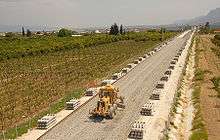
The new Corinth line branches off at SKA and runs west into Elefsis and the Megara Plains. The line passes through impressive tunnels and bridges in the "Kakia Skala" area, north of Agioi Theodoroi; while crossing the Corinth Canal over a new bridge and then into the New Corinth Station.
Currently, the line extends to the town of Kiato, where passengers can change to a TrainOSE bus services to Patras or to the metre gauge network. There is work in progress to extend the line to Xylokastro and Aigio, while plans exist to extend the line to Patras.
Thessaloniki – Idomeni
This is a single track electrified line, connecting Thessaloniki with Idomeni, near the border with the Republic of Macedonia. It is mostly used by international freight.
Secondary rail network
Thessaloniki – Edessa – Amyntaio – Kozani / Florina

This line was opened in 1894, and connects Thessaloniki with the city Bitola, in the southern part of the Republic of Macedonia. It passes through Platy, Veroia, Edessa, Amyntaio, and Florina. At Amyntaio the Kozani–Amyntaio railway branches off. The section between Thessaloniki and Platy is part of the important connection towards Athens and southern Greece. The part across the border with Macedonia is not used anymore, and passenger traffic has been suspended west of Edessa.
Thessaloniki – Alexandroupoli – Svilengrad

This railway line, 620 km long, joins Thessaloniki via the Port of Alexandroupoli to Svilengrad in Bulgaria, passing through or near most major cities of East Macedonia and Thrace (Serres, Drama, Xanthi, Komotini). At Strymon, the line connects with a northbound line along Strymon River Valley to Promachonas, which then joins with the Bulgarian network at Kulata. The line section from Stavroupoli to Toxotes runs along Nestos River Valley and is part of a preserved area that is not accessible by road.
From Alexandroupolis, the line continues northwards, where it runs alongside the Evros River, that marks the border between Greece and Turkey. A junction is located at Pythio, where a line continues east and crosses into Turkey towards Istanbul. On the Greek side, the line continues north over the Karaağaç cut off to Ormenio, the northernmost village of Greece. There the line crosses to the Bulgarian border town of Svilengrad. The distance from Alexandroupolis to Ormenio is 178 km.
Lianokladi - Stylis
A railway line which joins Stylida with Lamia and Lianokladi.
Thessaly Rail Network
Larissa – Volos

The 1,435 mm (4 ft 8 1⁄2 in) standard gauge, single-track branch line from Larissa to the port of Volos (61 km) was completed in 1960 along the route of a former 1,000 mm (3 ft 3 3⁄8 in) metre gauge line. It branches off the Athens–Thessaloniki mainline at Larissa crossing the Northern part of the Thessalian Plain to Velestino, formerly a junction with the now disused Volos–Palaiofarsalos section. From Velestino it descends rapidly to the port of Volos, initially running parallel to the abandoned metre gauge line and then diverging through Melissiatika. Volos was the terminus for both lines, and also for the Pelion railway to Milies. Engine sheds and marshalling yards at Volos are home to many abandoned relics of the Greek railway system. There is a regular service on this line. The station at Volos was, at one time, unique in being the terminus of three different gauges of railway line, notably standard gauge, metre gauge, and 600 mm (1 ft 11 5⁄8 in) gauge.
Palaiofarsalos – Kalampaka
The West Thessaly single track line to Kalambaka, recently converted to 1,435 mm (4 ft 8 1⁄2 in) , branches off the Athens–Thessaloniki mainline at Palaiopharsalos. The line serves the cities of Karditsa and Trikala, the towns of Sofades and Kalambaka; and the tourist attraction of Meteora. In the past, this line was part of a 1,000 mm (3 ft 3 3⁄8 in) line from Velestino to Kalambaka, crossing the main line at Palaiofarsalos. The eastern section to Velestino, still metre gauge, is maintained by enthusiasts as a heritage railway.
Peloponnese metre gauge network
Peloponnese network belonged since its construction to the former Piraeus, Athens and Peloponnese Railways or SPAP (Greek: Σιδηρόδρομοι Πειραιώς Αθηνών Πελοποννήσου, Sidiródromi Pireós Athinón Peloponnísou; ΣΠΑΠ) until 1962 when they were merged to Hellenic State Railways or SEK (Greek: Σιδηρόδρομοι Ελληνικού Κράτους, Sidiródromi Ellinikoú Krátous; ΣΕΚ).[8]
All passenger service on the metre gauge network in the Peloponnese (except the Diakofto Kalavrita Railway) was suspended in 2011. Some special passenger trains are able to run on demand of touroperators.[9]
Athens – Corinth – Kiato (metre gauge)
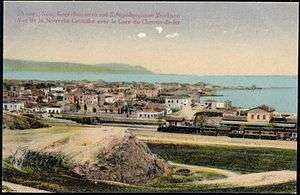
The old metre gauge Piraeus–Patras railway line of Piraeus, Athens and Peloponnese Railways, which ran from Piraeus, Athens to Corinth, now remains in operation only between Agioi Anargyroi and Corinth for departmental and freight services. The track from Piraeus to Agioi Anargyroi has been removed. It is double-track between Agioi Anargyroi and Elefsis (near Athens), while for the rest of its remaining section it is single and non-electrified.
After Ano Liosia, the line runs north and west of the Aegaleo mountain range into Eleusis and onwards to the Megara plain. After nine km it reaches Kakia Skala, running between the old and new highways. It then continues between the mountain and the sea, passing next to the Corinth Refinery, crossing the Corinth Canal into the Peloponnese and on into the Old Station in Corinth on the Southern banks of the Gulf of Corinth.
A short branch line at Isthmos leads to the town of Loutraki.
Kiato – Patras
The 1,000 mm (3 ft 3 3⁄8 in) metre gauge line to Patras runs through attractive scenery along the south side of the Gulf of Corinth, the northern coast of the Peloponnese.
At Diakofto, a seaside resort between Corinth and Patras, there is a junction with the Diakofto Kalavrita Railway, a 750 mm (2 ft 5 1⁄2 in) gauge rack and pinion line which climbs to a height of 720 m during a 22 km journey to Kalavryta through the Vouraikos Gorge. This line is known to Greeks as the "Odontotos" ("The train with teeth").
The main line continues alongside the gulf, passing to the north of Aigio and on to Patras. The Patras train station is situated next to the port near Othonos-Amalias Avenue. An old steam locomotive, c. 1900, lies to the east. The engine sheds and rolling stock depot are located to the northeast next to Norman Street. A freight marshalling yard is near Agios Andreas, although there are no longer freight services on the metric line.
Services on this section were suspended on 17 August 2009 due to work in progress for the line regaugung to standard gauge.[10][11] TrainOSE announced that services will be reinstated on the western part of the line (Diakopto-Patras) on 27 September 2009. A bus service currently serves major stations between Kiato and Patras with no set end date for the service and the works on the line as of July 2010.
Patras – Lechaina – Pyrgos – Olympia

The line Patras–Kato Achaia–Lechaina–Amaliada–Pyrgos–Olympia is about 150 km long and runs through the prefectures of Achaia and Ilia. The train runs to the east of Akti Dymaion and alongside the Gulf of Patras between the old and the new highways as far as Kato Achaia, where it passes along the bed of the ravine, 4 km from GR-9/E55 to Lappa. The route then runs to the north of forested land, passing into Nea Manolada, then west of the highway to Lechaina. There used to be a junction with the Kavasila–Kyllini/Loutra Kyllinis branch line here, but this branch has since been abandoned. The line continues southwest to Kardamas and then into Douneika, moving away from the hills before reaching Pyrgos. It passes Pyrgos to the north, shortly branching left to the south west, leaving the main line for Kyparissia and Kalamata. The track runs into the hills, passing through Varvasena and then into the terminus at Olympia.
Pyrgos – Katakolo
Another 13 km branch line, originally operated by a separate company Σιδηρόδρομος Πύργου–Κατακώλου (Pyrgos–Katakolo Railway), opened in 1883 to link Pyrgos with the port of Katakolo. This line had its own terminal in Pyrgos. Later, in 1951, this railway was taken over by SPAP and trains were diverted into the SPAP station. The line was modernized in 2007 and is used for a limited passenger service.
Pyrgos – Kalo Nero – Kyparissia/Zevgolatio
The line runs along the bed of the Alpheus river, east of GR-9/E55, then through Zacharo and into the plain westward with a few forested hills northwest of Kaiafa. It runs for most of its length west of the highway, passing into Zacharo and through Neochori and Tholon. At Kalo Nero, the main line turns east and runs inland, joining Corinth–Argos–Tripoli–Kalamata line at Zevgolatio while a short branch continues south from Kalo Nero down the coast to Kyparissia.
Corinth – Argos – Nafplion – Tripoli – Kalamata
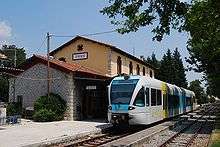
The line branches off from the Athens–Corinth–Patras line, one km west of Corinth Old Station, with a spur entering the Corinth New Station. The line passes through Argos, where there is a branch line of ten km from Argos to Nafplion. It continues on to Tripoli and Lefktro, where a short branch line connects Megalopoli to the main line. In Zevgolatio, the line joins the line from Pyrgos–Kyparissia and continues on to Kalamata. This line used to continue from the main station of Kalamata to the old station of "Kalamata Limin" (Kalamata Harbor), now used as an open air railway museum, and it came to an end at the Port of Kalamata. Track of this last section from Kalamata main station to the port still exists but is no longer in use.
Work is in progress on this line, especially between Tripolis and Kalamata, and details are liable to change. Passenger services on the section between Corinth, Argos, Tripolis, and Nafplion resumed on 1 August 2009.
Messene – Kalamata

This single-track line is a branch of the Corinth–Argos–Tripoli–Kalamata line and is 4.7 km long. The branch starts at Asprochoma then the track follows the GR-82 road closely on the southern side. The line was opened in 1892 and linked Kalamata with Messene where a station building and a freight yard were built. It was closed in 1976, but the tracks were not removed.
The line was rebuilt and reopened in September 2007. From 2013 to 2016, there is an occasional operation, from 20 until 28 September, during the Messene's festival and to the Christmas period until 10 January.
Other lines
Diakofto–Kalavryta Railway
The Diakofto–Kalavryta rail line is a historic 750 mm (2 ft 5 1⁄2 in) gauge rack railway in Greece. Located on the northern Peloponnese, it runs 22 km from Diakofto through the Vouraikos Gorge and the old Mega Spilaion Monastery and up to Kalavryta, stopping en route at Zachlorou.[12] The line was built by the Piraeus, Athens and Peloponnese Railways (SPAP). Currently the infrastructure and rolling stock are owned and maintained by the Hellenic Railways Organisation (OSE).
The line climbs from sea level to 720 m in 22.3 km with a maximum gradient of 17.5%. There are three sections with Abt system rack for a total of 3.8 km. Maximum speed is 40 km/h for adhesion sections and 12 km/h for rack sections.[13]
Pelion Railway Line
The 600 mm (1 ft 11 5⁄8 in) gauge 27 km line from Volos to Milies, a distance of 28 km, was constructed between 1903 and 1906 by the Italian engineer Evaristo De Chirico. The railway was first opened in 1906. It is an independent line, not a continuation of the one metre gauge Volos to Kalambaka line. Although abandoned in the 1970s, it has been restored from Ano Lechonia to Milies. A twice weekly "tourist train" operates during the summer on Saturdays and Sundays. This is occasionally headed by one of the two restored 2-6-0 steam locomotives. The train climbs to a height of 450 metres during its 22 km journey from Ano Lechonia, a journey which takes one and a half hours. The old station at Milies has been converted into a restaurant with guest rooms. When all three gauge railways were operating from Volos, this gave the station the unique distinction of being terminus to three different gauges of railway. The Pelion railway played a major role in the economic development of the Pelion region. The stations that serve this line are rarely operational, but they still exist.

Athens – Airport Line
In 2004, a new line was inaugurated running from Acharnai (SKA) junction to Athens International Airport "El Venizelos" Between Iraklio and Koropi, the new line runs along a closed motorway (Attiki Odos), along the general direction of the old Lavrio line, but displaced east. The line is double-track and electrified with 25;kV overhead catenary. When the planned extension from Koropi to Lavrio is built, it will probably follow the old Lavrio line more closely.
Abandoned lines
Paleofarsalos – Velestino – Volos
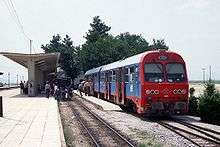
This was formerly a 1,000 mm (3 ft 3 3⁄8 in) line throughout its length from Volos to Kalampaka. However, the track from Paleofarsalos to Kalampaka/Meteora is now 1,435 mm (4 ft 8 1⁄2 in) . The remainder of the metre gauge line from Paleofarsalos to Velestino is no longer in use, though in part it is maintained as a heritage railway by the non-profit Company for Museum Railways (Εταιρεία Μουσειακών Σιδηροδρόμων) or EMOS (ΕΜΟΣ). EMOS now operates a Linke-Hoffman DMU on loan from OSE, an old Nippon Saryo diesel locomotive, formerly of Aliveri Lignite Mines and various rail cars. They also own and plan to return to operational condition a Jung steam locomotive, while other rolling stock shall remain as display items (a Tubize steam locomotive, a Breda railbus etc.).[14]
Kavasila – Vartholomio – Kyllini
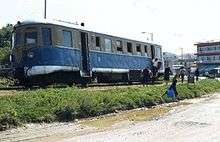
This 16 km long branch line, part of the SPAP network, served the port of Kyllini, from which ferries sail to Zakynthos Island. Services on this branch started in August 1891 and lasted until 1988, with full services and with limited services until 1996, when the line was closed down.
This line also included the 10.8 km branch Vartholomio–Loutra Kyllinis railway line, which opened in June 1892 and closed down in 1969.[15]
Kryoneri – Missolonghi – Agrinio
This metre gauge line that was opened in the 1890s linked the small port of Kryoneri with Missolonghi and Agrinio. A short branch from Aitoliko to Katochi was in operation from 1912 to 1940. From Kryoneri to Patras, a ferryboat service was provided. The expense of the ferry, the increase in private car traffic, and the hostility of local authorities led to the closure of the line for passenger traffic in 1970 and for departmental traffic in 1975.[16]
In the 1990s, a plan to restore and reopen the line was started. The track was modernized and work finished in 2003, but passenger services have not been restored, due to lack of personnel and rolling stock.
Other
A number of lines were closed before 1971 and subsequently the track was lifted. They include Sarakli-Savros, Angista-Ampipolis, Alexandroupolis bypass, Skydra-Almopia and Herakleion Kule-Xeropotamos.[17]
Planned lines
Igoumenitsa-Ioannina-Kalampaka
Kalampaka-Kastoria
Florina-Pogradec
Kalampaka-Kozani
Thessaloniki-Kavala-Toxotes
Ioannina-Rio
Thessaloniki-Chalkidiki
Thessaloniki-Giannitsa-Skydra
Chania-Rethymnon-Herakleion Crete[18]
Thessaloniki-Igoumenitsa (On March 8, 2016 were signed an intergovernmental agreement between Greece and Turkey for reconnecting the line Istanbul to Thessaloniki with an enhancement to Igoumenitsa with the goal to create the Egnatia Railway)[19]
A line between Alexandroupolis and Varna shall connect in future the two towns.[20]
Railway services
Headquarters
The headquarters of OSE are at 1–3 Karolou St., Athens 104 37, Greece.
Photo gallery
 The original station in Nafplion. No longer used for trains. Now a cafe, museum site and municipal conservatory.
The original station in Nafplion. No longer used for trains. Now a cafe, museum site and municipal conservatory. The station in Nafplion, March 2008
The station in Nafplion, March 2008 Old train in Nafplion
Old train in Nafplion Kalamata station, circa 1910
Kalamata station, circa 1910 Narrow gauge rolling stock under restoration in Volos Engine Sheds.
Narrow gauge rolling stock under restoration in Volos Engine Sheds.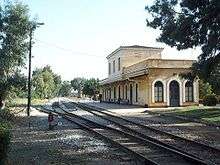 Argos Station. Southern circuit of Peloponnese 1 m. gauge line.
Argos Station. Southern circuit of Peloponnese 1 m. gauge line. Volos Station exterior (1892) View in 1990.
Volos Station exterior (1892) View in 1990. Volos station in 1995. The tracks are mixed gauge. Both trains are metric gauge DMU for Kalampaka.
Volos station in 1995. The tracks are mixed gauge. Both trains are metric gauge DMU for Kalampaka.
See also
- Railways of Greece
- TrainOSE
- Hellenic Railways Organisation rolling stock
- Proastiakos
- Kozani-Amyntaio railway line
- Diakofto Kalavrita Railway
- Greek railway signalling
- Budapest–Belgrade–Skopje–Athens railway
Notes and references
- ↑ http://www.yme.gr/?getwhat=7&tid=21&aid=2199&id=
- ↑ Income
- ↑ ErgOSE
- ↑ Law 674/1971, Government Gazette A-192/1970
- ↑ "Network Statement 2007". (1.29 MB). EDISY S.A., Athens, 2006.
- ↑ Greek Government Gazette issue TAE-EPE 13557/2010-11-29, pages 1–2 (ΦΕΚ ΤΑΕ-ΕΠΕ 13557/2010-11-29)
- ↑ "Network Statement 2011". (1.29 MB)
- ↑ Official webpage of Greek railways infrastructure – Piraeus-Athens-Peloponnese railways (greek)
- ↑ railwaytouring
- ↑ Circular no 3619759/4 August 2009 (urgent) by EDISY S.A., Timetables Department (in greek).
- ↑ Πολύμηνη διακοπή των δρομολογίων ΚΙΑΤΟΥ – ΠΑΤΡΩΝ (11 August 2009)
- ↑ "Diakofto Kalavrita Railway". IgoUgo. Retrieved 24 April 2006.
- ↑ H. Pyrgidis. Railway Transportation Systems (Greek: Συστήματα Σιδηροδρομικών Μεταφορών) (in Greek). Thessaloniki, Greece: Zitis. p. 702. ISBN 978-960-456-155-1.
- ↑ heritage railway
- ↑ I. Zartaloudis, D. Karatolos, D. Koutelidis, G. Nathenas, S. Fasoulas, A. Filippoupolitis, A. (1997). Οι Ελληνικοί Σιδηρόδρομοι (Hellenic Railways) (in Greek). Μίλητος (Militos). p. 213. ISBN 960-8460-07-7.
- ↑ I. Zartaloudis, D. Karatolos, D. Koutelidis, G. Nathenas, S. Fasoulas, A. Filippoupolitis, A. (1997). Οι Ελληνικοί Σιδηρόδρομοι (Hellenic Railways) (in Greek). Μίλητος (Militos). p. 238. ISBN 960-8460-07-7.
- ↑ Voyageur (Anonymous) (February 1941). "The Railways of Greece". The Railway Magazine. London, UK: Railway Publications. 87 (524): 64.: Contains a map of Hellenic Railways in 1940–1941.
- ↑ Το τρένο θα σφυρίξει στην Κρήτη
- ↑ Συμφωνία για υπερταχεία Θεσσαλονίκης-Κωνσταντινούπολης
- ↑ Tsipras in Sofia: Auftrieb für griechisch-bulgarische Beziehungen, Retrieved 02. December 2016
Further reading
- "General Rail Traffic Regulation – Part A- Signals Regulation and Appendices I, II, III, IV, V & VI" (Greek: Γενικός Κανονισμός Κυκλοφορίας – Μέρος Α – Κανονισμός Σημάτων και Παραρτήματα I, II, III, IV, V & VI) , Hellenic Railways Organisation, electronic edition (2009).
- "General Rail Traffic Regulation – Part B" (Greek: Γενικός Κανονισμός Κυκλοφορίας – Μέρος Β) , Hellenic Railways Organisation, electronic edition (2009).
- ERAIL Greece monograph, report submitted to the European Commission, DG Transport and Energy, Version 6, Rijswijk, The Netherlands, 2005.
- I. Zartaloudis, D. Karatolos, D. Koutelidis, G. Nathenas, S. Fasoulas, A. Filippoupolitis, A. (1997). Οι Ελληνικοί Σιδηρόδρομοι (Hellenic Railways) (in Greek). Μίλητος (Militos). ISBN 960-8460-07-7. It is the only extensive and authoritative source for the history of Greek railways until 1997.
- Simms, W.F. (1997). The railways of Greece. Wilfried F. Sims. ISBN 0-9528881-1-4. Contains brief history, simple line maps and extensive list of rolling stock until 1997.
- Organ, J. (2006). Greece Narrow Gauge. Middleton Press. ISBN 1-904474-72-1.
- Greece – Railway Map (2nd Edition). London, UK: The Quail Map Company . 1992. ISBN 0-900609-85-0. External link in
|publisher=(help) - OSE Main Website (English version)
- OSE Permanent Way Engineering Department website. Currently only in Greek.
- TrainOSE S.A. website (including timetables, but check for accuracy.)
- Robert Schwandl (2004). "Line 1 Piraeus – Kifissia". UrbanRail.Net. Retrieved 8 June 2008.: A history of the development of the Athens urban and suburban lines from 1869, with emphasis to EIS/ISAP lines.
- Greek Trainscapes — Handrino, Kakavas, Fotis
- Stations, Trains and Horizons — Yannis Skoulas
- Stations in History — Lefteris Papayanakis
- ERGOSE S.A.
- Proastiakos S.A. (Suburban Railway)
- (Greek) Hellenic Association of the Friends of the Railway
- Messinian Association of the Friends of the Railway
- Flag of Greek Railways Organization
- (Greek) Web page about Greek Railways, by D. Tertipis
- "Railroad Photos by Panos" Railway photography gallery, mostly about Hellenic Railways, by Panos Nakoudis.
- "Railway systems in Greece". Cheltenham, UK: The Restoration & Archiving Trust. 2007. Retrieved 21 May 2008.
- "Amnizia" Site of friends of the Greek railways, rich in photography
External links
![]() Media related to Rail transport in Greece at Wikimedia Commons
Media related to Rail transport in Greece at Wikimedia Commons